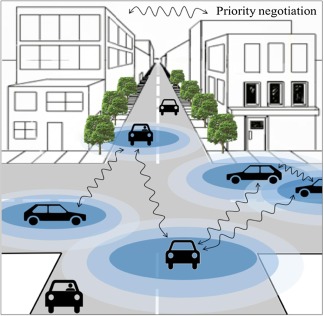-
July 17, 2019
Researchers from WSU and Stony Brook find a way to decrease both travel time and risk of collision

Mehrdad Tajalli and Ali Hajbabaie from PacTrans constituent university, WSU, alongside Amir Mirheli and Leila Hajibabai from Stony Brook University in New York, had their paper, “A consensus-based distributed trajectory control in a signal-free intersection,” published in Transportation Research Board Part C: Emerging Technologies last January.
The paper, which the team had been working on since 2018, explores the development of, “a distributed cooperative control logic to determine conflict-free trajectories for connected and automated vehicles (CAVs) in signal-free intersections.” (Mirheli, Tajalli, Hajibabai, & Hajbabaie, 2019).
The cooperative trajectory planning problem is expressed as vehicle-level mixed integer nonlinear programs (MINLPs), which Hajbabaie also worked with and describes in another research paper. In this case, the MINLPs are intended to decrease the travel time and speed variations of vehicles, while maintaining safety and avoiding collisions.
CAVs were used to design a coordination scheme, which observes any conflicting movements between vehicles and records their states, such as location, on a prediction horizon. This information is then relayed into a CAV’s MINLPs, allowing the CAVs to better determine the route that will take the least amount of travel time that is also the most conflict-free.
Some of the research highlights include:
- “Development of a consensus-based control logic for the movement of CAVs through signal-free intersections.
- “Development of CAV-level mixed-integer nonlinear programs.
- “Minimizing each CAV’s travel time and speed variations while avoiding near-crash conditions.
- “Development of a distributed coordinated algorithm to obtain real-time CAV trajectories.
- “Achieving 43% to 70.5% reduction in travel time under various demand levels.” (Mirheli et al., 2019).
To view the complete paper, click here.

